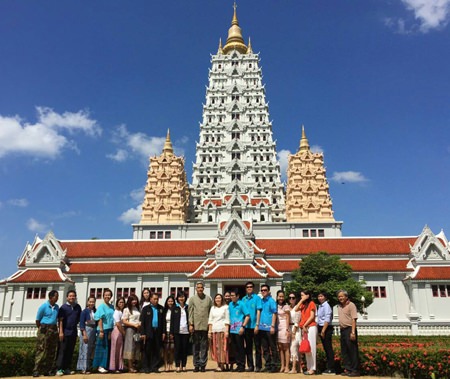Pattaya city, tourism and business leaders learned the history of Yansangwararam Temple as a step toward promoting it as a religious study center.
City Councilman Rattanachai Sutidechanai and TAT Pattaya office Director Suladda Sarutilavan led the Oct. 30 field trip to the Banglamung District temple with councilors and members of the Pattaya Business & Tourism Association.
The group engaged in merit-making, offering alms to monks and listening to a lecture by Phra Kru Sarapaiyaprakard about the history of the wat and Buddha Gaya Pagoda. They also heard about a Buddha’s enlightenment exhibition at the pagoda and Pramaha Mondob Phra Buddha Bat Bhumibol Sirikit from Paothong Thongjua, an advisor to the Crown Property Bureau.
 Pattaya’s government, tourism and business leaders visit Yansangwararam Temple to learn its history as a step toward promoting it as a religious study center.
Pattaya’s government, tourism and business leaders visit Yansangwararam Temple to learn its history as a step toward promoting it as a religious study center.
Wat Yansangwararam is the monastery class royal temple located in Huay Yai. It was built in 1976 on about 300 rai of land. About 61 additional rai were added later.
It became a monastery in 1977 and was certified a Buddhist temple in 1980.
The current abbot is Somdej Prayannasangworn Samdejpra Sangkaraj Sakolmahaparinayok.
Pramaha Mondob Phra Buddha Bat Bhumibol Sirikit was built on the top of Khao Din Derm as a two-story reinforced-concrete building in a Mondob shape. Downstairs is divided into two parts. The first is a monk’s living space and the second is for water storage.
The top floor is the place for Buddha’s feet. Mondob is decorated with golden mosaic ties donated by the royal family. There are 200 stairs tiled with Thai granite.
Stone used to carve Buddha’s feet is granite measuring 1.7 meters wide, two meters long and 2.9 meters thick and weighing 35 tons. It was brought from a rubber plantation alongside Wat Sakthai in Chantaburi, and was donated by Witsawayota (Kao Chi Chan) Co., Ltd. Transport was provided by Sattahip Naval Base.
The royal pavilion was built by using coconut trees as poles. The structure was covered with bulrush to be a temporary pavilion. HM King Bhumibol Adulyadej the Great visited on June 27, 1984.




